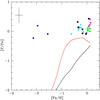| Issue |
A&A
Volume 584, December 2015
|
|
|---|---|---|
| Article Number | C1 | |
| Number of page(s) | 1 | |
| Section | Stellar atmospheres | |
| DOI | https://doi.org/10.1051/0004-6361/201526586e | |
| Published online | 13 November 2015 | |
The origin of fluorine: abundances in AGB carbon stars revisited (Corrigendum)
1 Dpto. Física Teórica y del Cosmos, Universidad de Granada, 18071 Granada, Spain
e-mail: cabia@ugr.es
2 Observatório Nacional, Rua General José Cristino, 77, 20921-400 São Critovão, Rio de Janeiro, RJ, Brazil
3 INAF, Osservatorio Astronomico di Collurania, 64100 Teramo, Italy
4 INFN Sezione Napoli, Napoli, Italy
5 Laboratoire Lagrange, Université Côte d’Azur, Observatoire de la Côte d’Azur, CNRS, CS 34229, 06304 Nice Cedex 4, France
Key words: stars: AGB and post-AGB / stars: abundances / nuclear reactions, nucleosynthesis, abundances / errata, addenda
 |
Fig. 4 [F/Fe] vs. [Fe/H] observed in Galactic field dwarfs and giants and open cluster stars compared with the predicted evolution from our GCE model for the solar neighbourhood including only fluorine production from AGB stars. Black line: yields from Cristallo et al. (2015); red line: yields from Karakas (2010). The observed ratios (circles) are from Recio-Blanco et al. (2012; black), Li et al. (2013; blue), Maiorca et al. (2014; green), Jönsson et al. (2014; cyan), and Nault & Pilachowski (2013; magenta). A typical error bar is shown. See text for details. |
Figure 4 has been corrected. In the previous version of this figure theoretical curves had a systematic offset in the [F/Fe] ratio by a factor ~0.2 dex upwards. This has been corrected in the present version (below). This correction does not have any consequence on the conclusions of the paper. In fact, it shows even more clearly that, independently of the F yields from asymptotic giant branch (AGB) stars used (whether from Karakas 2010 or from Cristallo et al. 2015) in a simple Galactic chemical evolution model, it is impossible to account for the observed [F/Fe] ratios at the epoch of the solar system formation ([Fe/H] ≈ 0.0). Therefore, other F sources are required. The caption of Fig. 4 remains the same.
References
- Cristallo, S., Abia, C., Straniero, O., & Piersanti, L. 2015, ApJ, 801, 53 [NASA ADS] [CrossRef] [Google Scholar]
- Jönsson, H., Ryde, N., Harper, G. M., Richter, M. J., & Hinkle, K. H. 2014, ApJ, 789, L41 [NASA ADS] [CrossRef] [Google Scholar]
- Karakas, A. I. 2010, MNRAS, 403, 1413 [NASA ADS] [CrossRef] [Google Scholar]
- Li, H. N., Ludwig, H.-G., Caffau, E., Christlieb, N., & Zhao, G. 2013, ApJ, 765, 51 [NASA ADS] [CrossRef] [Google Scholar]
- Maiorca, E., Uitenbroek, H., Uttenthaler, S., et al. 2014, ApJ, 788, 149 [NASA ADS] [CrossRef] [Google Scholar]
- Nault, K. A., & Pilachowski, C. A. 2013, AJ, 146, 153 [NASA ADS] [CrossRef] [Google Scholar]
- Recio-Blanco, A., de Laverny, P., Worley, C., et al. 2012, A&A, 538, A117 [NASA ADS] [CrossRef] [EDP Sciences] [Google Scholar]
© ESO, 2015
All Figures
 |
Fig. 4 [F/Fe] vs. [Fe/H] observed in Galactic field dwarfs and giants and open cluster stars compared with the predicted evolution from our GCE model for the solar neighbourhood including only fluorine production from AGB stars. Black line: yields from Cristallo et al. (2015); red line: yields from Karakas (2010). The observed ratios (circles) are from Recio-Blanco et al. (2012; black), Li et al. (2013; blue), Maiorca et al. (2014; green), Jönsson et al. (2014; cyan), and Nault & Pilachowski (2013; magenta). A typical error bar is shown. See text for details. |
| In the text | |
Current usage metrics show cumulative count of Article Views (full-text article views including HTML views, PDF and ePub downloads, according to the available data) and Abstracts Views on Vision4Press platform.
Data correspond to usage on the plateform after 2015. The current usage metrics is available 48-96 hours after online publication and is updated daily on week days.
Initial download of the metrics may take a while.


